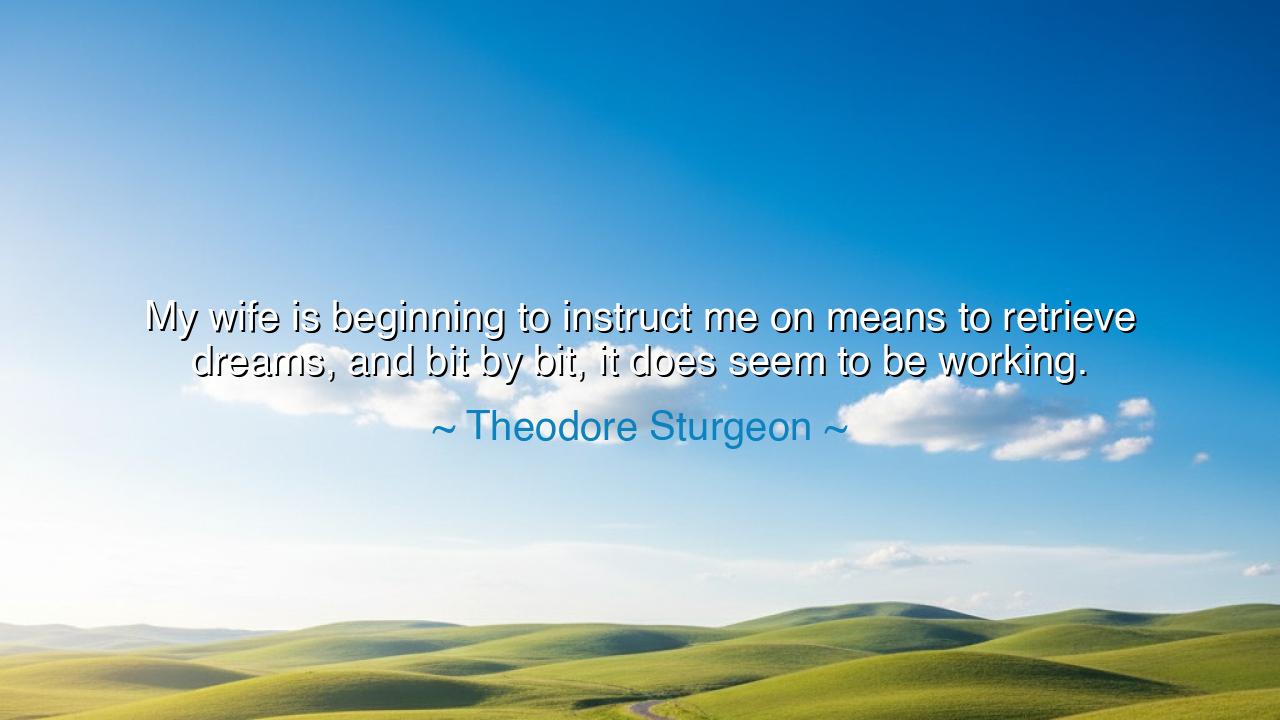
My wife is beginning to instruct me on means to retrieve dreams
My wife is beginning to instruct me on means to retrieve dreams, and bit by bit, it does seem to be working.






The words of Theodore Sturgeon, master of science fiction and poet of the human heart, emerge with a tenderness both humble and profound: “My wife is beginning to instruct me on means to retrieve dreams, and bit by bit, it does seem to be working.” Though simple on the surface, these words reveal a truth both intimate and universal — that the world of dreams is not lost to us, but can be called back, gently, through patience, trust, and love. In this small confession, Sturgeon unveils a greater wisdom: that the human spirit, even in its waking reason, longs to reconnect with the mystery from which it came. His quote speaks of a shared journey — the union of two souls seeking access to that silent realm where imagination, memory, and meaning entwine.
The origin of these words lies not only in Sturgeon’s personal life, but in his lifelong fascination with the boundary between the real and the imagined. As a writer, he explored the edges of human consciousness — the tender places where science meets wonder, and logic yields to mystery. Yet here, he writes not as a visionary of galaxies, but as a man rediscovering the landscapes within himself. His wife, guiding him in the retrieval of dreams, becomes both teacher and companion in an ancient practice: the art of remembering what the soul whispers in sleep. The phrase “bit by bit” reveals not frustration, but reverence — a recognition that the path to self-knowledge is gradual, like dawn breaking through fog.
In the days of old, the ancients held dreams in sacred esteem. The Egyptians called them messages from the gods, sent to guide the living; the Greeks built temples of sleep where seekers might receive healing visions from the divine. Even Aristotle wrote that dreams were the workings of the soul when freed from the body’s senses. Sturgeon, centuries later, stands in that same lineage of seekers — but his approach is not through ritual or theology, but through intimacy. The dream, for him, is not a cosmic decree, but a personal revelation — one that can be recovered with love, patience, and a willingness to listen. The partnership he describes — his wife instructing, he learning — mirrors the balance of waking and dreaming, mind and heart, reason and intuition.
To “retrieve dreams” is to reclaim a forgotten language. Most people let their dreams fade at dawn, dismissing them as chaos or shadow-play. Yet within those fleeting images lie the stories our deeper selves are trying to tell. The child we once were, the griefs we buried, the desires we deny — all live and breathe in that hidden country. Sturgeon’s wife, teaching him how to draw them back, acts as a priestess of the inner world, guiding him toward that communion. She shows him that remembering is not a trick of memory, but a ritual of attention — to wake gently, to linger in stillness, to write what remains before the sun burns it away. In this, she performs what the ancients called the art of remembrance, the act of bringing the unseen into light.
There is a quiet beauty in the humility of his words. Sturgeon, a man of imagination vast enough to craft universes, admits that he is learning — slowly, and with help. In this, he teaches us something greater than the act of dream recall: he teaches us openness. Too often, we believe knowledge must be conquered, that mastery means control. But the dream cannot be forced; it must be invited. It reveals itself to the gentle, not the arrogant. The phrase “bit by bit” becomes a mantra for all seekers — a reminder that the unfolding of truth takes time, and that growth often comes through the hands of those who love us enough to guide us inward.
We might recall the story of Carl Jung, who, like Sturgeon, saw in dreams a bridge between the conscious mind and the collective soul of humanity. When Jung began recording his dreams, he did not find chaos — he found patterns, symbols, and archetypes that spoke of the eternal. From them, he forged a map of the psyche that changed the world’s understanding of the human spirit. His journey began, as Sturgeon’s did, with the act of remembering — of daring to treat his inner visions not as noise, but as truth. So too can each of us begin, if we have the courage to listen to what our sleeping selves are trying to say.
And so, my children, the lesson is clear: do not let your dreams slip silently into oblivion. They are not mere echoes of thought, but living messages — the voices of your deeper wisdom. Learn, as Sturgeon did, to retrieve them bit by bit. Upon waking, hold still; let the images return before the rush of day sweeps them away. Write them down, reflect on them, and let them speak to you. Ask what they reveal about your fears, your longings, your destiny. And if you find it difficult, seek a guide — someone who, like Sturgeon’s wife, can remind you that patience and love are the keys to remembrance.
For dreams are the oldest teachers of humankind. They are the threads that connect our waking days to the eternal night from which all creation was born. To retrieve them is to reclaim your wholeness, to awaken not just to the world around you, but to the vast universe within. So listen, and learn — for the dream, once forgotten, is waiting still, whispering your own name.






AAdministratorAdministrator
Welcome, honored guests. Please leave a comment, we will respond soon